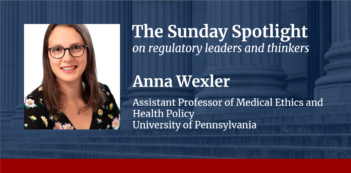
Experts discuss FDA’s COVID-19 emergency authorizations and how to recalibrate the regulatory mechanism.
When COVID-19 entered the United States, individuals across the nation took urgent measures to adapt. But they were not alone. Government agencies charged with protecting the nation’s health also mobilized to provide access to necessary medical products.
Under the Federal Food, Drug, and Cosmetic Act, the Secretary of the U.S. Department of Health and Human Services (HHS) declared the COVID-19 pandemic a public health emergency justifying emergency use authorizations (EUAs) of various products used to control the virus. In turn, the U.S. Food and Drug Administration (FDA) authorized the use of otherwise unapproved medical products for COVID-19 testing, treatment, and vaccination.
To issue an EUA, FDA has to verify that several criteria for each product have been met: (1) the product responds to a serious or life-threatening emergency, (2) the given product “may be effective” as a countermeasure to that emergency, (3) the known and potential benefits outweigh the known and potential risks, and (4) there are no approved alternatives available.
Yet the EUA pathway serves as a relatively novel regulatory tool for FDA. An EUA brings a product to market based on the best available evidence rather than waiting for all the evidence typically required for full FDA clearance. FDA issued its first EUA in 2005 for use of an anthrax vaccine—Adsorbed—and it has since issued EUAs in response to five other infectious disease outbreaks.
Since the start of the COVID-19 pandemic, FDA has issued over 600 EUAs for personal protective equipment, drug products, medical equipment, diagnostics, and vaccines. Such unprecedented use of emergency authorizations distinguishes the COVID-19 pandemic from past public health crises. For instance, FDA issued only 22 EUAs during the H1N1 pandemic.
In addition to FDA’s response, former HHS Secretary Alex Azar invoked the Public Readiness and Emergency Preparedness Act in February 2020, affording private manufacturers, health professionals, and other individuals identified by the Secretary of HHS broad legal immunities for all COVID-19 countermeasures authorized via an EUA.
The proliferation of EUAs during the COVID-19 pandemic has captured the attention of experts, provoking concern about the normalization of a process which sidesteps the traditional approval mechanism. Expedited access, some experts argue, must be weighed against FDA’s rigorous safety and efficacy standards. In addition, experts worry that the current EUA pathway remains susceptible to political influence because the statutory standard for issuing an EUA leaves room for undue discretion.
In this week’s Saturday Seminar, scholars explore the use of EUAs during the COVID-19 pandemic and how FDA officials could recalibrate the EUA mechanism for future public health emergencies.
- In an article published in the Food and Drug Law Journal, Efthimios Parasidis, Micah L. Berman, and Patricia J. Zettler of The Ohio State University argue that FDA issued an unprecedented number of EUAs based on sparse evidence due to the pressurized pandemic context. Parasidis, Berman, and Zettler suggest ways to improve the EUA framework under FDA’s existing statutory authority, including requiring manufacturers to complete more exacting clinical trials, conditioning EUAs on robust post-market observational studies, and issuing guidance identifying a risk-based framework for evaluating device EUAs. They also contend that the U.S. Congress should consider amending the Federal Food, Drug, and Cosmetic Act to incorporate a more robust standard for vaccine EUAs due to their unique clinical and ethical concerns.
- In an article published in the Journal of Law and the Biosciences, Walter G. Johnson and Gary E. Marchant of the Arizona State University Sandra Day O’Connor College of Law contend that the history of public health legislation is characterized by “punctuated equilibrium,” long stretches of stability followed by new crises that prompt brief periods of rapid change. Johnson and Marchant explain that nearly every major change in the legislative authority of public health agencies, such as FDA and EPA, stems from high-profile public tragedies or crises attributable, at least in part, to regulatory failures. Thus, as a prominent public health crisis, the COVID-19 pandemic created a policy window for reforming diagnostics and vaccine regulation, argue Johnson and Marchant. They fear, however, that by bypassing procedural norms, emergency policymaking will result in regulatory programs that do not address longer-term interests and concerns.
- In an article in the Food and Drug Law Journal, Yaniv Heled of Georgia State University College of Law, Ana Santos Rutschman of Saint Louis University School of Law, and Liza Vertinsky of Emory University School of Law claim that public health emergencies require regulatory agencies, including FDA and the Centers for Disease Control and Prevention (CDC), to engage in evidence-based decision-making. Heled, Rutschman, and Vertinsky argue that “regulatory reactivity,” a mode of regulation that departs from evidence-based decision-making in response to external pressures, is problematic because it favors short-term problem-solving over long-term public health goals. Although the existing legal framework fails to address regulatory reactivity, insulating agencies from external influences, establishing decision-making procedures for emergency situations in advance, and increasing the level of scrutiny applied to agency decisions during emergencies could reduce negative impacts, according to Heled, Rutschman, and Vertinsky.
- The rapid authorization and revocation of FDA’s authorization of hydroxychloroquine to treat COVID-19 illustrates concerns about the EUA process, argue Kyle Thomson, former counsel with the American Medical Association, and Herschel Nachlis of Dartmouth College in an article in the Journal of the American Medical Association. Issues such as a lack of scientific evidence and pressure from advocacy groups without health expertise present complications for FDA regulators. Thomson and Nachlis contend that health-related advisory committees and accessible communication with the greater public will improve FDA’s efforts to protect public health while ensuring high standards and accountability.
- National regulatory bodies must examine the use of EUAs during the COVID-19 pandemic to ensure adequate procurements, approvals, and imports of essential medical products in future crises, argue Almir Badnjevic of the University of Warwick and several coauthors. In a paper published in BioMedical Engineering Online, the Badnjevic team praises FDA’s defined validation process for mechanical ventilator EUAs, which allowed manufacturers to make minor modifications to already approved products and control the ventilator shortage. Similarly, FDA published quality systems regulations to ensure safe production of personal protective equipment. Still, the authors warn that EUAs carry risks. In response, the Badnjevic team recommends that regulatory bodies define minimum technical specifications and coordinate an international inventory database of medical products to maintain consistent diagnostic standards.
- In an article published in Health Affairs, Aaron S. Kesselheim of Harvard Medical School and several coauthors assess FDA’s vaccine approval mechanisms, comparing the traditional approval process to the EUA process employed during the COVID-19 pandemic. The Kesselheim team’s review of recent vaccine trials found that the majority of such trials used immunogenicity—the tendency of a vaccine to trigger an immune response—to measure efficacy, as opposed to the more traditional metric of disease incidence, such as the rate of new cases of a disease. But immunogenicity is a less reliable metric when dealing with a novel pathogen, according to the Kesselheim team. Balancing accelerated availability and safety considerations, Kesselheim and his coauthors argue that FDA should continue to use the EUA pathway for vaccines during public health crises but also implement post-approval systems to detect adverse events, such as the CDC’s Vaccine Safety Datalink, and vaccine injury compensation programs.
The Saturday Seminar is a weekly feature that aims to put into written form the kind of content that would be conveyed in a live seminar involving regulatory experts. Each week, The Regulatory Review publishes a brief overview of a selected regulatory topic and then distills recent research and scholarly writing on that topic.



